Table of Contents
Human Reproduction Important Questions for CBSE Class 12 Biology Gametogenesis
1.Gametogenesis is the process of producing gametes (sperms and ova by the testis and ovary, respectively).
It is of the following two types:
(i)Spermatogenesis
(ii)Oogenesis
2.Spermatogenesis is production of sperms in males.
(i) In testis, the immature male germ cells (spermatogonia) produce sperms by spermatogenesis that begins at puberty.
(ii)Spermatogonia (sing, spermatogonium) present on the inside wall of seminiferous tubules multiply by mitotic division and increase in numbers.
(iii) Each spermatogonium is diploid and contains 46 chromosomes. Some of the spermatogonia called primary spermatocytes periodically undergo meiosis.
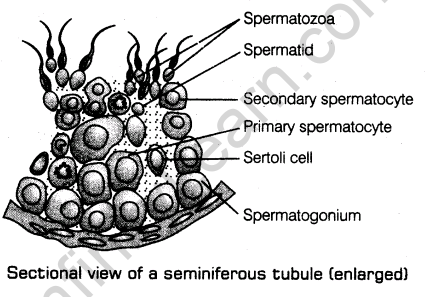
(iv)A primary spermatocyte undergo first meiotic division leading to two equal, haploid cells called secondary spermatocytes, which contains only 23 chromosomes each.
(v)The secondary spermatocytes undergo the second meiotic division to produce four equal, haploid spermatids.
(vi) The spermatids are transformed into spermatozoa (sperms) by the process called spermiogenesis.
(vii) Sperm heads are embedded in the Sertoli cells and are finally released from the seminiferous tubules by the process called spermiation.
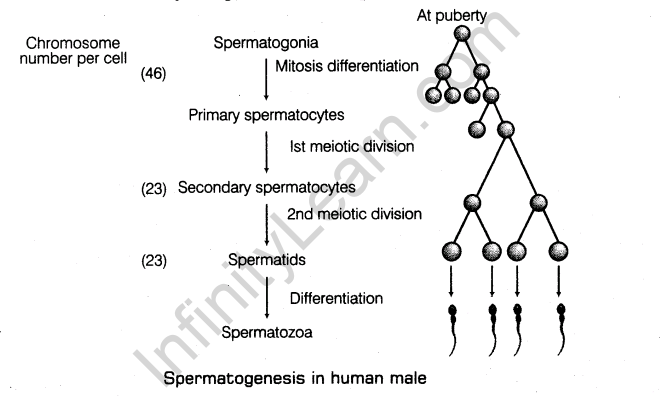
3.Role of Hormones in Spermatogenesis
(i)Spermatogenesis starts during puberty with the significant increase in hypothalamic hormone called Gonadotropin Releasing Hormone (GnRH).
(ii)The increased level of GnRH acts on the anterior pituitary gland and stimulates the secretion of two gonadotropins, i.e. LH (Luteinising Hormone) and FSH (Follicle Stimulating Hormone).
(iii) LH acts on the Leydig cells and stimulating the synthesis and secretion of androgens. Androgens in turn stimulate the process of spermatogenesis.
(iv) FSH acts on Sertoli cells and stimulates the secretion of some factors, which help in the process of spermiogenesis.
4.Structure of a Sperm
(i)A sperm is composed of a head, neck, a middle piece and a tail.
(ii)A plasma membrane encloses the whole body of sperm.
(iii)Head contains an elongated haploid nucleus, the anterior portion of which is covered by a cap-like structure called acrosome.
(iv)The acrosome is filled with enzymes that help in fertilisation of the ovum.
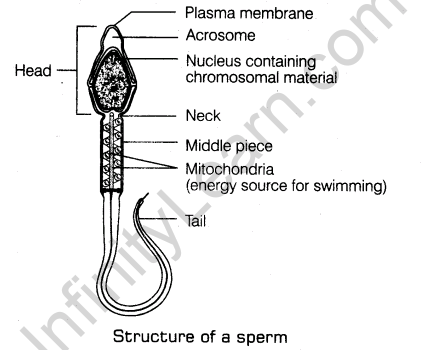
(v)Neck contains two centrioles, a proximal centriole which is necessary for first cleavage division of zygote and a distal centriole, that gives rise to axial filament of tail
(vi)Middle piece possesses many mitochondria to produce energy for the movement of tail to facilitate sperm motility.
(vii)Tail of the sperm consists of an axial filament. Its role is to help movement inside the female reproductive tract towards the ovum for fertilisation.
5.Oogenesis is the process of formation of a female gamete or ova in the ovary.
(i)It starts during embryonic stage in a female.
(ii)About a million oogonia are formed in the ovary of the female foetus (of 25 weeks). No new oogonia are formed after birth.
(iii)The oogonial cells start meiotic division, enter into prophase-I, get temporarily arrested at that stage and are called as primary oocytes.
(iv)Each primary oocyte then gets surrounded by a layer of granulosa cells called primary follicle.
(v)A large number of primary follicles degenerate during the phase from birth to puberty. As a result, about 60,000-80,000 primary follicles are left in each ovary at puberty.
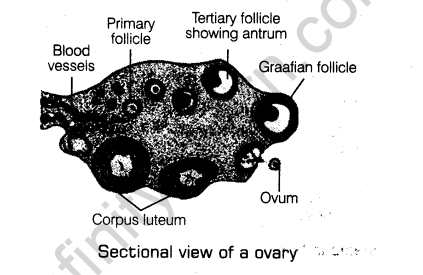
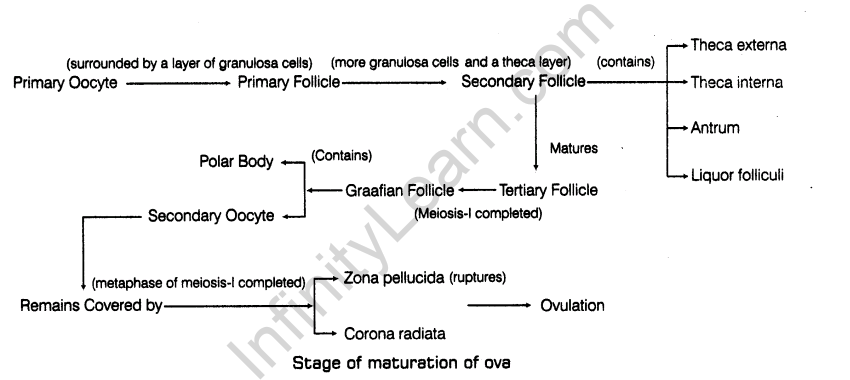
(vi)The primary follicles get surrounded by more layers of granulosa cells and a new theca and are called secondary follicles.
(vii)The thecal layer in secondary follicles become organised into an outer theca externa and an inner theca interna. This stage is called tertiary follicle.
(viii)Tertiary follicle is characterised by a fluid-filled cavity called antrum.
(ix)At this stage, the primary oocyte within the tertiary follicle grows in size and completes its first meiotic division.
(x)The first meiotic division which is unequal results in the formation of haploid secondary oocyte and tiny first polar body.
(xi)Secondary oocyte retains bulk of the nutrient rich cytoplasm of the primary oocyte.
(xii)The tertiary follicle develops into a mature follicle or Graafian follicle.
(xiii)The secondary oocyte forms a new membrane called zona pellucida surrounding it.
(xiv)The Graafian follicle ruptures to release the secondary oocyte (ovum) from the ovary by the process called ovulation.
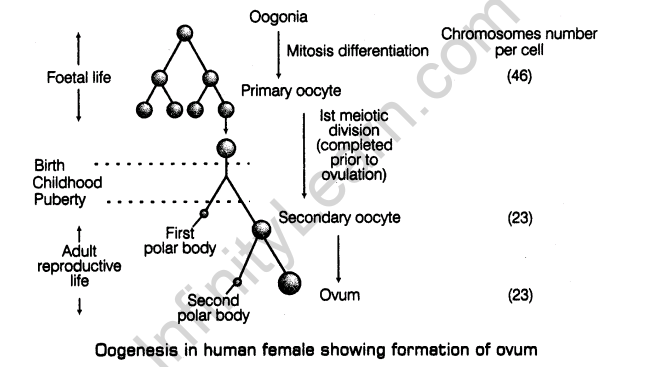
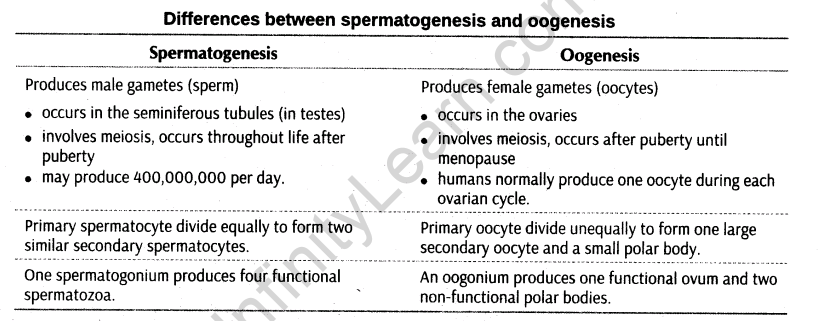
6.Menstrual cycle is a rhythmic change in the reproductive organs of the female
primates (monkey, apes and humans).
(i) The first menstruation begins at puberty and is called menarche.
(ii)Average interval of menstruation in human female is about 28-29 days.
(iii)The cyclic events starting from one menstruation till the next one constitute menstrual cycle.
(iv)The four phases of menstrual cycle are:
Menstrual Phase
(a)Cycle starts with this phase and the menstrual flow occurs for 3-5 days.
(b)It occurs due to breakdown of endometrial lining of the uterus. The blood vessels form liquid which along with unfertilised ovum comes out through the vagina.
(c)Menstruation occurs only if fertilisation does not takes place.
(d)Lack of menstruation generally indicates pregnancy but may also be due to stress, poor health, diseases, etc.
Follicular or Proliferative Phase
(a)Menstrual phase is followed by the follicular phase.
(b)The primary follicle in the ovary grow to become a fully mature Graafian follicle and simultaneously the endometrium of uterus regenerates through proliferation.
(c)Pituitary and ovarian hormones induce the changes in ovary and uterus.
(d)LH and FSH levels increase gradually during this phase and stimulates follicular development.
(e)The growing follicles secrete oestrogens.
(f)Both LH and FSH attain highest level during mid-cycle (about 14th day).
Ovulatory Phase
(a) Rapid secretion of LH leading to its maximum level during the mid-cycle is called LH surge.
(b) The LH surge induces rupture of Graafian follicle, releasing the ovum called ovulation
Luteal Phase/Secretory Phase
(a)Ovulatory phase is followed by the luteal phase.
(b)The remaining parts of the ruptured Graafian follicle changes into corpus luteum.
(c)Corpus luteum secretes large amounts of progesterone, which is required for the maintenance of endometrium.
(d)The thickened endometrium is necessary for the implantation of fertilised ovum and maintenance of pregnancy.
(e)During pregnancy, all the events of menstrual cycle stop and menstruation does not occur.
(f)In case of no fertilisation, the corpus luteum degenerates. This causes rupture of endometrium leading to menstruation – initiation of a new cycle.
(g)In human females, menstrual cycle stops around the age of 50 years called as menopause
(v)Menstrual cycle is absent temporarily during pregnancy and lactation periods and permanently after menopause
(vi)Menstruation is also called ‘Weeping of uterus for the lost ovum’ or ‘Funeral of unfertilised eggs’.
Previous Year Examination Questions
1 Mark Questions
1.When do the oogenesis and the spermatogenesis initiate in human females and males, respectively?[Delhi 2012]
Ans.Oogenesis initiates in foetal or embryonic
stage of females, whereas spermatogenesis, in males starts at puberty.
2.Mention the differences between spermiogenesis and spermiation.[Delhi 2012]
Ans.Difference between spermiogenesis and spermiation is:
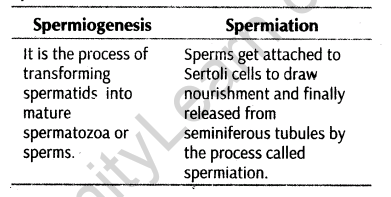
3.Where is acrosome present in humans? Write its function.[All India 2012]
Ans.In humans, the acrosome is present in the anterior portion of head of the human sperm. Function Enzymes present in acrosome help in contact and penetration into egg, during fertilisation of the ovum
4.List the changes the primary oocyte undergoes in the tertiary follicular stage in human embryo.[Foreign 2011]
Ans.In human embryo, the primary oocyte grows in size, completes meiosis-l and forms a larger cell, the secondary oocyte and a smaller cell, the first polar body.
2 Marks Questions
5.Write the effect of high concentrations of LH on a mature Graafian follicle. [All India 2014]
Ans. The high concentration of LH induces the rupture of Graafian follicle which results in release of secondary oocyte and thus causing ovulation in females.
6.Differentiate between
(i)Vas deferens and vasa efferentia
(ii)Spermatogenesis andspermiogenesis. [Delhi 2014]
Ans.
7.Draw and label the parts of the head region only of a human sperm.[Delhi 2014 C]
Ans.Diagram showing head of human sperm is The acrosome is filled with enzymes that help in fertilisation of the ovum.

(i)Neck contains two centrioles, a proximal centriole which is necessary for first cleavage division of zygote and a distal centriole, that gives rise to axial filament of tail
(ii)Middle piece possesses many mitochondria to produce energy for the movement of tail to facilitate sperm motility.
(iii)Tail of the sperm consists of an axial filament. Its role is to help movement inside the female reproductive tract towards the ovum for fertilisation.
8.Differentiate between menarche and menopause. [All India 2010]
Ans.Differences between menarche and menopause are:
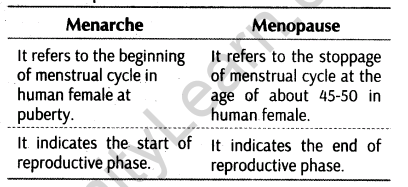
9.Differentiate between major structural changes in the human ovary during the follicular and luteal phase of the menstrual cycle.[All India 2010]
Ans. Differences between follicular and luteal phase are:
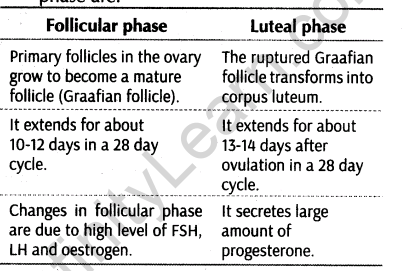
10.Mention the fate of corpus luteum and its effect on the uterus in the absence of fertilisation of the ovum in human female. [Foreign 2010]
Ans.The corpus luteum degenerates in the absence of fertilisation. The endometrium layer of uterus disintegrates along with blood and unfertilised ovum leading to menstrual flow.
11.Study the sectional view of human testis showing seminiferous tubules given below.
(i)Identify A, B and C.
(ii)Write the function of A and D.[Foreign 2010]
Ans.(i) A-Spermatogonia, 8-Interstitial cells C-Spermatozoa.
(ii) A-Spermatogonia produce the .. spermatozoa (sperms) D-Sertoli cells provide nutrition to the germ cells.
12.How and at what stage of menstrual cycle is corpus luteum formed in human females? When does it regress? [Delhi 2010c]
Ans.After ovulatory phase (ovulation), the luteal phase starts. The remaining parts of ruptured Graafian follicle transform as corpus luteum in this phase. The corpus luteum secretes large amount of progesterone which is essential for the maintenance of endometrium.In the absence of fertilisation, the corpus luteum degenerates causing disintegration of endometrium leading to menstruation
13.Explain the role of Sertoli cells in the development of sperms. [Delhi 2010 c]
Ans.Sertoli cells provide nourishment to developing sperms. After spermiogenesis, sperm heads become embedded in the Sertoli cells to draw nutrition for further development.
14.Mention the role of gonadotropins in menstrual cycle. On what day of the menstrual cycle do the gonadotropins reach a peak?[All India 2009]
Ans.Gonadotropins, i.e. LH and FSH levels increases gradually during the follicular phase and secretory phase respectively FSH stimulate follicular development and secretion of oestrogens by the growing follicles, while LH stimulates the corpus luteum to secrete progesterone.Both LH and FSH attain a peak level in the middle of cycle, i.e. about 14th day of menstrual cycle.
15.Draw a labelled diagram of a human sperm. [All India 2008 C]
Ans.Diagram showing head of human sperm is The acrosome is filled with enzymes that help in fertilisation of the ovum.

(i)Neck contains two centrioles, a proximal centriole which is necessary for first cleavage division of zygote and a distal centriole, that gives rise to axial filament of tail
(ii)Middle piece possesses many mitochondria to produce energy for the movement of tail to facilitate sperm motility.
(iii)Tail of the sperm consists of an axial filament. Its role is to help movement inside the female reproductive tract towards the ovum for fertilisation.
16.Mention the sites of action of the ‘hormone GnRH and FSH during spermatogenesis in human males.Give one, function of each of the hormones [All India 2008 C]
Ans.GnRH or gonadotropin releasing hormone is a hypothalamic hormone. Spermatogenesis starts at puberty due to its significant increase.Its increased levels acts on anterior pituitary gland and stimulates the secretion of LH and FSH. LH acts on the Leydig cells and stimulates synthesis and secretion of androgens. FSH acts on Sertoli cells, which stimulates the secretion of some factors that help in spermiogenesis.
3 Marks Questions
17.Draw a labelled diagram of the sectional view of a human seminiferous tubule (six parts to be labelled).[Delhi 2014,2010]
Ans.Spermatogenesis is production of sperms in males.
(i) In testis, the immature male germ cells (spermatogonia) produce sperms by spermatogenesis that begins at puberty.
(ii)Spermatogonia (sing, spermatogonium) present on the inside wall of seminiferous tubules multiply by mitotic division and increase in numbers.
(iii) Each spermatogonium is diploid and contains 46 chromosomes. Some of the spermatogonia called primary spermatocytes periodically undergo meiosis.

(iv)A primary spermatocyte undergo first meiotic division leading to two equal, haploid cells called secondary spermatocytes, which contains only 23 chromosomes each.
(v)The secondary spermatocytes undergo the second meiotic division to produce four equal, haploid spermatids.
(vi) The spermatids are transformed into spermatozoa (sperms) by the process called spermiogenesis.
(vii) Sperm heads are embedded in the Sertoli cells and are finally released from the seminiferous tubules by the process called spermiation.

18.Explain the hormonal control of spermatogenesis in humans.[Foreign 2014]
Ans.GnRH or gonadotropin releasing hormone is a hypothalamic hormone. Spermatogenesis starts at puberty due to its significant increase.Its increased levels acts on anterior pituitary gland and stimulates the secretion of LH and FSH. LH acts on the Leydig cells and stimulates synthesis and secretion of androgens. FSH acts on Sertoli cells, which stimulates the secretion of some factors that help in spermiogenesis
19.Draw a diagram of human sperm. Label only those parts along with their functions, that assist the sperm to reach and gain entry into the female gamete. [Foreign 2014]
Ans.The parts of a human sperm, along with their functions that assist sperm to reach and gain entry into ovum are labelled as:
Diagram showing head of human sperm is The acrosome is filled with enzymes that help in fertilisation of the ovum.

(i)Neck contains two centrioles, a proximal centriole which is necessary for first cleavage division of zygote and a distal centriole, that gives rise to axial filament of tail
(ii)Middle piece possesses many mitochondria to produce energy for the movement of tail to facilitate sperm motility.
(iii)Tail of the sperm consists of an axial filament. Its role is to help movement inside the female reproductive tract towards the ovum for fertilisation.
20.Draw a labelled diagram of the microscopic structure of a human sperm. [Foreign 2011]
Ans.Diagram showing head of human sperm is The acrosome is filled with enzymes that help in fertilisation of the ovum.

(i)Neck contains two centrioles, a proximal centriole which is necessary for first cleavage division of zygote and a distal centriole, that gives rise to axial filament of tail
(ii)Middle piece possesses many mitochondria to produce energy for the movement of tail to facilitate sperm motility.
(iii)Tail of the sperm consists of an axial filament. Its role is to help movement inside the female reproductive tract towards the ovum for fertilisation.
21.Describe how the changing levels of FSH, LH and progesterone during menstrual cycle induce changes in the ovary and the uterus in human female? [Foreign 2011]
Ans.Menstrual cycle in human female is under hormonal control in the following ways:
(i) Follicular or proliferative phase is under the influence of FSH from the anterior pituitary.
(ii)The follicular cells of mature follicle secrete oestrogens, which control the growth and maintenance of the secondary sex organs like uterus, Fallopian tube, etc.
(iii) FSH and LH reach their peak level around the mid-cycle (14th day). The peak level of LH surge causes the rupture of Graafian follicle and release of ovum (ovulation).
(iv) LH influences the remaining parts of Graafian follicle to transform into corpus luteum.
(v)Corpus luteum secretes large quantity of progesterone in the luteal phase. Progesterone is required for the growth and maintenance of endometrium of uterus for implantation.
(vi)In the absence of fertilisation, the high levels of progesterone exert negative feed back on the pituitary. This stops the secretion of LH and corpus luteum degenerates leading to menstruation
22.Spermatogenesis in human males is a hormone regulated process. Justify. [Foreign 2010]
Ans.Hormonal control of spermatogenesis in human males:
(i) Gonadotropin Releasing Hormone (GnRH) is released significantly from the hypothalamus during puberty.
(ii) GnRH stimulate anterior pituitary to secrete gonadotropins, i.e. LH and FSH or Interstitial Cell Stimulating Hormone (ICSH).
(iii)Leuteinising Hormone (LH) acts on Leydig cells to stimulate synthesis and secretion of androgens. Androgens stimulates the process of spermatogenesis.
(iv) Follicle Stimulating Hormone (FSH) acts on Sertoli cells and stimulates them to secrete certain factors which are necessary for the process of spermiogenesis.
23.Mention the target cells of luteinising hormone in human males and females. Explain the effect and the changes which the hormone induces in each case.[Delhi 2009]
Ans.(i)Target cells of Luteinising Hormone in Males are Leydig cells.Females are mature follicles.
(ii) LH stimulates the Leydig cells in male to secrete testosterone, which controls spermatogenesis. In females, LH stimulates ovulation, formation of corpus luteum and secretion of progesterone by corpus luteum.
24.Name the source of gonadotropins in human females. Explain the changes brought about in the ovary by these hormones during menstrual cycle. [Foreign 2009]
Ans.The source of gonadotropins is anterior pituitary.
Menstrual cycle is a rhythmic change in the reproductive organs of the female
primates (monkey, apes and humans).
(i) The first menstruation begins at puberty and is called menarche.
(ii)Average interval of menstruation in human female is about 28-29 days.
(iii)The cyclic events starting from one menstruation till the next one constitute menstrual cycle.
(iv)The four phases of menstrual cycle are:
Menstrual Phase
(a)Cycle starts with this phase and the menstrual flow occurs for 3-5 days.
(b)It occurs due to breakdown of endometrial lining of the uterus. The blood vessels form liquid which along with unfertilised ovum comes out through the vagina.
(c)Menstruation occurs only if fertilisation does not takes place.
(d)Lack of menstruation generally indicates pregnancy but may also be due to stress, poor health, diseases, etc.
Follicular or Proliferative Phase
(a)Menstrual phase is followed by the follicular phase.
(b)The primary follicle in the ovary grow to become a fully mature Graafian follicle and simultaneously the endometrium of uterus regenerates through proliferation.
(c)Pituitary and ovarian hormones induce the changes in ovary and uterus.
(d)LH and FSH levels increase gradually during this phase and stimulates follicular development.
(e)The growing follicles secrete oestrogens.
(f)Both LH and FSH attain highest level during mid-cycle (about 14th day).
Ovulatory Phase
(a) Rapid secretion of LH leading to its maximum level during the mid-cycle is called LH surge.
(b) The LH surge induces rupture of Graafian follicle, releasing the ovum called ovulation
Luteal Phase/Secretory Phase
(a)Ovulatory phase is followed by the luteal phase.
(b)The remaining parts of the ruptured Graafian follicle changes into corpus luteum.
(c)Corpus luteum secretes large amounts of progesterone, which is required for the maintenance of endometrium.
(d)The thickened endometrium is necessary for the implantation of fertilised ovum and maintenance of pregnancy.
(e)During pregnancy, all the events of menstrual cycle stop and menstruation does not occur.
(f)In case of no fertilisation, the corpus luteum degenerates. This causes rupture of endometrium leading to menstruation – initiation of a new cycle.
(g)In human females, menstrual cycle stops around the age of 50 years called as menopause
(v)Menstrual cycle is absent temporarily during pregnancy and lactation periods and permanently after menopause
(vi)Menstruation is also called ‘Weeping of uterus for the lost ovum’ or ‘Funeral of unfertilised eggs’.
25.(i) Draw a sectional view of human ovary. Label the following parts
(a)Primary follicle
(b)Ovum
(c)Graafian follicle
(d)Corpus luteum
(ii) Name the hormones influencing
(a)Ovulation
(b)Development of corpus luteum. [Delhi 2009C]
or
Draw a labelled diagram of a sectional view of human ovary showing various stages of follicles growing in it. [Delhi 2008]
Ans.(I)Oogenesis is the process of formation of a female gamete or ova in the ovary.
(i)It starts during embryonic stage in a female.
(ii)About a million oogonia are formed in the ovary of the female foetus (of 25 weeks). No new oogonia are formed after birth.
(iii)The oogonial cells start meiotic division, enter into prophase-I, get temporarily arrested at that stage and are called as primary oocytes.
(iv)Each primary oocyte then gets surrounded by a layer of granulosa cells called primary follicle.
(v)A large number of primary follicles degenerate during the phase from birth to puberty. As a result, about 60,000-80,000 primary follicles are left in each ovary at puberty.


(vi)The primary follicles get surrounded by more layers of granulosa cells and a new theca and are called secondary follicles.
(vii)The thecal layer in secondary follicles become organised into an outer theca externa and an inner theca interna. This stage is called tertiary follicle.
(viii)Tertiary follicle is characterised by a fluid-filled cavity called antrum.
(ix)At this stage, the primary oocyte within the tertiary follicle grows in size and completes its first meiotic division.
(x)The first meiotic division which is unequal results in the formation of haploid secondary oocyte and tiny first polar body.
(xi)Secondary oocyte retains bulk of the nutrient rich cytoplasm of the primary oocyte.
(xii)The tertiary follicle develops into a mature follicle or Graafian follicle.
(xiii)The secondary oocyte forms a new membrane called zona pellucida surrounding it.
(xiv)The Graafian follicle ruptures to release the secondary oocyte (ovum) from the ovary by the process called ovulation.


(II)(a) Ovulation Luteinising Hormone (LH) and FSH
(b)Development of corpus luteum is influenced by LH but corpus luteum secretes progesterone.
26.Explain the development of an ovum from an oogonium in a human female. [All India 2009 C]
Ans.Development of ovum from an oogonium in a human female.
(i) Oogonium which enters meiosis-l is the primary oocyte. Division remains suspended in prophase-l.
(ii)Primary oocyte becomes surrounded by a layer of granulosa cells and is called the primary follicle.
(iii) Primary follicle gets surrounded by more granulosa cells and a thecal layer. This stage is called secondary follicle.
(iv) A cavity develops in the secondary follicle around the primary oocyte called antrum.
(v)Thecal layer becomes organised into an outer theca externa and an inner theca interna. This stage is called tertiary follicle.
(vi)Primary oocyte completes its meiosis-l and forms a large cell-the secondary oocyte and a tiny cell-the first polar body.
(vii)Tertiary follicle transforms into a mature follicle called Graafian follicle (mature ovum).
27.Study the figure given below
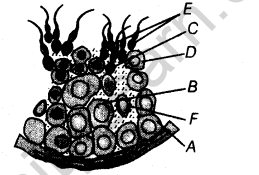
(i)Pick out and name the cells that undergo spermiogenesis.
(ii)Name A and B What is the difference between them with reference to the number of chromosomes?
(iii)Pick out and name the motile cells.
(iv)What is F cell? Mention its function.
(v)Name the structure of which the diagram is a part. [Foreign 2008]
Ans.(i)The cells that undergo spermiogenesis are:C-Spermatids, D-Secondary spermatocyte
(ii) A-Spermatogonium B-Primary spermatocyte They both are diploid and have 46 chromosomes in each.
(iii)E-Spermatozoa are motile cells.
(iv) E-Sertoli cells. It provides nourishment to the germ cells.
(v) The above diagram is a section of seminiferous tubule.
5 Marks Questions
28.(i) How is ‘oogenesis’ markedly different from ‘spermatogenesis’ with respect to the growth till puberty in the humans?
(ii)Draw a sectional view of human ovary and label the different follicular stages, ovum and corpus luteum. [Delhi 2014]
Ans.(i) Oogenesis is markedly different from spermatogenesis in the following aspects.
(ii)Oogenesis is the process of formation of a female gamete or ova in the ovary.
(i)It starts during embryonic stage in a female.
(ii)About a million oogonia are formed in the ovary of the female foetus (of 25 weeks). No new oogonia are formed after birth.
(iii)The oogonial cells start meiotic division, enter into prophase-I, get temporarily arrested at that stage and are called as primary oocytes.
(iv)Each primary oocyte then gets surrounded by a layer of granulosa cells called primary follicle.
(v)A large number of primary follicles degenerate during the phase from birth to puberty. As a result, about 60,000-80,000 primary follicles are left in each ovary at puberty.


(vi)The primary follicles get surrounded by more layers of granulosa cells and a new theca and are called secondary follicles.
(vii)The thecal layer in secondary follicles become organised into an outer theca externa and an inner theca interna. This stage is called tertiary follicle.
(viii)Tertiary follicle is characterised by a fluid-filled cavity called antrum.
(ix)At this stage, the primary oocyte within the tertiary follicle grows in size and completes its first meiotic division.
(x)The first meiotic division which is unequal results in the formation of haploid secondary oocyte and tiny first polar body.
(xi)Secondary oocyte retains bulk of the nutrient rich cytoplasm of the primary oocyte.
(xii)The tertiary follicle develops into a mature follicle or Graafian follicle.
(xiii)The secondary oocyte forms a new membrane called zona pellucida surrounding it.
(xiv)The Graafian follicle ruptures to release the secondary oocyte (ovum) from the ovary by the process called ovulation.


29.Explain the ovarian and uterine events that occur during a menstrual cycle in a human female under the influence of pituitary and ovarian hormones, respectively. [Delhi 2014]
Ans.The cycle of events starting from one menstruation till next in female primates is called menstrual cycle. It comprises of four phases which is regulated by both pituitary and ovarian hormones that affects ovaries and uterus, respectively.
The events occurring in a menstrual cycle are:
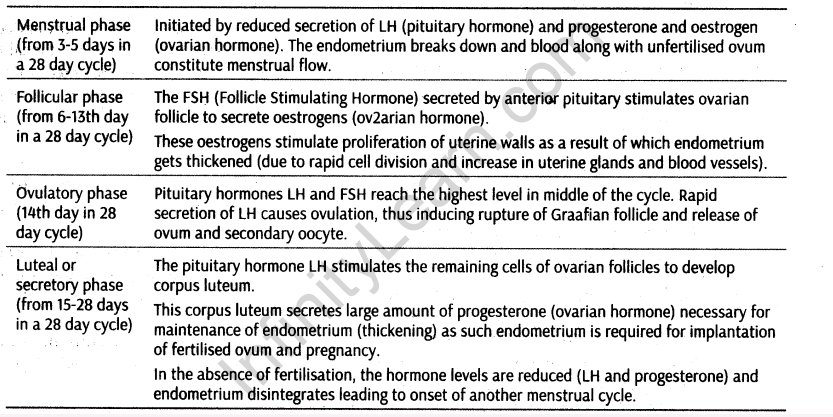
30.Schematically represent and explain the events of spermatogenesis in humans.[Delhi 2014 C]
Ans.(i) Spermatogenesis in human male.
Spermatogenesis is production of sperms in males.
(i) In testis, the immature male germ cells (spermatogonia) produce sperms by spermatogenesis that begins at puberty.
(ii)Spermatogonia (sing, spermatogonium) present on the inside wall of seminiferous tubules multiply by mitotic division and increase in numbers.
(iii) Each spermatogonium is diploid and contains 46 chromosomes. Some of the spermatogonia called primary spermatocytes periodically undergo meiosis.

(iv)A primary spermatocyte undergo first meiotic division leading to two equal, haploid cells called secondary spermatocytes, which contains only 23 chromosomes each.
(v)The secondary spermatocytes undergo the second meiotic division to produce four equal, haploid spermatids.
(vi) The spermatids are transformed into spermatozoa (sperms) by the process called spermiogenesis.
(vii) Sperm heads are embedded in the Sertoli cells and are finally released from the seminiferous tubules by the process called spermiation.

(ii)Spermatogenesis in humans.
(a)The process of formation of spermatozoa in the seminiferous tubules of testes is called spermatogenesis.
(b)The spermatogonia are present in the inner lining of seminiferous tubules. They multiply by mitotic division arid increase in number.
(c)Some of them undergo meiosis and become the primary spermatocytes.
(d)The primary spermatocytes undergo meiosis-1 and forms two haploid secondary spermatocytes.
(e)The secondary spermatocytes undergo meiosis-ll and form four equal sized haploid spermatids.
(f)Spermatids transform into the spermatozoa by spermiogenesis
(g)After spermiogenesis, the sperm heads are embedded inthe Sertoli cells and releasedfrom the seminiferous tubules.
31.Explain the different phases of menstrual cycle and correlate the phases with the different levels of pituitary hormones in a human female. [Delhi 2014c]
Ans.The cycle of events starting from one menstruation till next in female primates is called menstrual cycle. It comprises of four phases which is regulated by both pituitary and ovarian hormones that affects ovaries and uterus, respectively.
The events occurring in a menstrual cycle are:

32.(i) Draw a transverse section of a human ovary showing the sequential development of different follicles up to the corpus luteum.
(ii) Comment on the corresponding ovarian and pituitary hormone levels during these events.[Delhi 2014 C]
Ans.(a)Oogenesis is the process of formation of a female gamete or ova in the ovary.
(i)It starts during embryonic stage in a female.
(ii)About a million oogonia are formed in the ovary of the female foetus (of 25 weeks). No new oogonia are formed after birth.
(iii)The oogonial cells start meiotic division, enter into prophase-I, get temporarily arrested at that stage and are called as primary oocytes.
(iv)Each primary oocyte then gets surrounded by a layer of granulosa cells called primary follicle.
(v)A large number of primary follicles degenerate during the phase from birth to puberty. As a result, about 60,000-80,000 primary follicles are left in each ovary at puberty.


(vi)The primary follicles get surrounded by more layers of granulosa cells and a new theca and are called secondary follicles.
(vii)The thecal layer in secondary follicles become organised into an outer theca externa and an inner theca interna. This stage is called tertiary follicle.
(viii)Tertiary follicle is characterised by a fluid-filled cavity called antrum.
(ix)At this stage, the primary oocyte within the tertiary follicle grows in size and completes its first meiotic division.
(x)The first meiotic division which is unequal results in the formation of haploid secondary oocyte and tiny first polar body.
(xi)Secondary oocyte retains bulk of the nutrient rich cytoplasm of the primary oocyte.
(xii)The tertiary follicle develops into a mature follicle or Graafian follicle.
(xiii)The secondary oocyte forms a new membrane called zona pellucida surrounding it.
(xiv)The Graafian follicle ruptures to release the secondary oocyte (ovum) from the ovary by the process called ovulation.


(b) The level of correspondingovarian and pituitary hormones during the above described events in menstrual cycle can be explained with the help of given graph.
The pituitary hormones FSH and LH gradually increases during development of follicle (follicular phase) and reaches its peak level which induces ovulation.The ovarian hormones Oestrogen increases gradually till ovulation but decreases with increase in progesterone secretions by corpus luteum (after ovulation). These hormone secretions are reduced if ovum is not fertilised and corpus luteum degenerates, leading to menstrual flow.
33.(i) Draw a diagrammatic sectional view of a human seminiferous tubule and label Sertoli cells, primary spermatocyte, spermatogonium and spermatozoa in it.
(ii)Explain the hormonal regulation of the process of spermatogenesis.[All India 2013]
Ans.(i)
(ii)Hormonal control of spermatogenesis in human males:
(a) Gonadotropin Releasing Hormone (GnRH) is released significantly from the hypothalamus during puberty.
(b) GnRH stimulate anterior pituitary to secrete gonadotropins, i.e. LH and FSH or Interstitial Cell Stimulating Hormone (ICSH).
(c)Leuteinising Hormone (LH) acts on Leydig cells to stimulate synthesis and secretion of androgens. Androgens stimulates the process of spermatogenesis.
(d) Follicle Stimulating Hormone (FSH) acts on Sertoli cells and stimulates them to secrete certain factors which are necessary for the process of spermiogenesis.
34.The following is the illustration of the sequence of ovarian events (A-I) in a humans female.
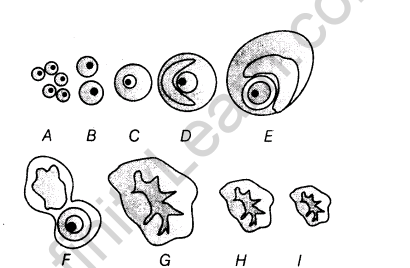
(i)Identify the figures that illustrates ovulation and mention the stage of oogenesis it represents.
(ii)Name the ovarian hormone and the pituitary hormone that have caused the above mentioned event.
(iii)Explain the changes that occur in the uterus simultaneously in anticipation.
(iv)Write the differences between C and H
(v)Draw a labelled sketch of the structure of a human ovum prior to fertilisation.[Delhi 2012]
Ans.(i)Figure’Fillustratesovulation.ltrepresents the ovulatory stage of oogenesis.
(ii)Progesterone is the ovarian hormone released during ovulation. Follicle Stimulating Hormone (FSH) and Luteinising Hormone (LH) are the pituitary hormones released during ovulation.
(iii)In anticipation of receiving the fertilised egg, the endometrium of the uterus gets thickened and also the blood supply to the endometrium increases.
(iv) The figure C stage represents the secondary follicle and the H stage represents the degenerating corpus luteum.

(v)Structure of a human ovum
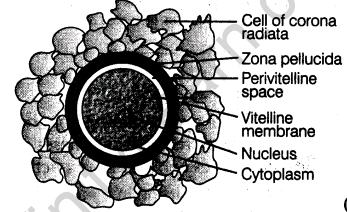
35.The following is the illustration of the sequence of ovarian events A to I in a human female
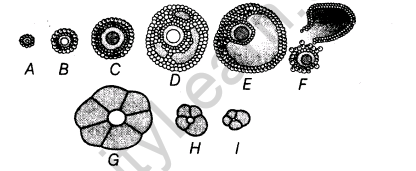
(i)Identify the figures that illustrates corpus luteum and name the pituitary hormone that influences its formation.
(ii)Specify the endocrine function of corpus luteum. How does it influence the uterus? Why is it essential?
(iii)What is the difference between D and E?
(iv)Draw a neat labelled sketch of Graafian follicle. [Delhi 2012]
Ans.(i) C is corpus luteum. LH secreted by pituitary influences its formation.
(ii) The endocrine function of corpus luteum is that it secretes progesterone.Progesterone is essential for the maintenance of endometrium layer of uterus.Such a thickened endometrium is necessary for implantation of the fertilised ovum and other events of pregnancy.
(iii)D is a developing secondary follicle, whereas E is a mature tertiary follicle.
(iv)Structure of a Graafian follicle is
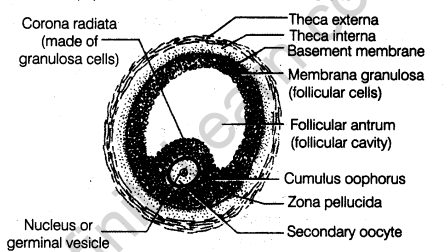
36(i) Describe the stages of oogenesis in human females.
(ii) Draw a labelled diagram of a human ovum released after ovulation. [Delhi 2012]
Ans.(i)Development of ovum from an oogonium in a human female.
(a) Oogonium which enters meiosis-l is the primary oocyte. Division remains suspended in prophase-l.
(b)Primary oocyte becomes surrounded by a layer of granulosa cells and is called the primary follicle.
(c) Primary follicle gets surrounded by more granulosa cells and a thecal layer. This stage is called secondary follicle.
(d) A cavity develops in the secondary follicle around the primary oocyte called antrum.
(e)Thecal layer becomes organised into an outer theca externa and an inner theca interna. This stage is called tertiary follicle.
(f)Primary oocyte completes its meiosis-l and forms a large cell-the secondary oocyte and a tiny cell-the first polar body.
(h)Tertiary follicle transforms into a mature follicle called Graafian follicle (mature ovum).
(ii)Structure of a human ovum

37.(i) When and where does spermatogenesis occur in human male?
(ii)Draw a diagram of a mature human male gamete. Label the following parts acrosome, nucleus, middle piece and tail.
(iii)Mention the function of acrosome and middle piece. [Delhi 2011]
Ans.(i) Spermatogenesis begins during puberty and continues throughout the reproductive period in human males. Site of spermatogenesis is seminiferous tubule of the testis.
(ii) Structure of human male gamete (sperm).
Diagram showing head of human sperm is The acrosome is filled with enzymes that help in fertilisation of the ovum.

(i)Neck contains two centrioles, a proximal centriole which is necessary for first cleavage division of zygote and a distal centriole, that gives rise to axial filament of tail
(ii)Middle piece possesses many mitochondria to produce energy for the movement of tail to facilitate sperm motility.
(iii)Tail of the sperm consists of an axial filament. Its role is to help movement inside the female reproductive tract towards the ovum for fertilisation.
(iii) Acrosome It contains enzymes required to dissolve the ovum membranes to facilitate contact and penetrate ovum for fertilisation.
Middle piece It contains plenty of mitochondria to produce energy for the movement of sperm.
38.When and where are primary oocytes formed in a human female? Trace the development of these oocytes till ovulation (in menstrual cycle). How do gonadotropins influence this developmental process? [Delhi 2010]
or
Explain the different stages of oogenesis in humans starting from foetal life till its completion. When and where in the body is oogenesis completed? [Delhi 2009]
Ans.(i)In human females, primary oocytes are formed during the embryonic developmental stages in the foetal ovaries.
(ii) (a) Primary oocytes start dividing and enter prophase-l of meiosis to remain suspended at this stage.
(b) Each primary oocyte is surrounded by a layer of granulosa cells and become the primary follicle.
(c) The primary follicle when surrounded by more layers of granulosa cells, is called a secondary follicle.
(d)Secondary follicle transforms into a tertiary follicle, with the developmentof a fluid-filled cavity (antrum) around the primary oocyte.
(e)Granulosa cells become organised into an outer theca externa and an inner theca interna.
(f) Now, primary oocyte completes meiosis-l and forms a larger haploid secondary oocyte and a tiny first polar body.
(g)Tertiary follicle grows and becomes a mature follicle called Graafian follicle.
(h)Secondary oocyte secretes a new membrane called zona pellucida around it.
(i)At this stage, follicle ruptures to release the secondary oocyte, which moves into the cytoplasm
(j)Secondary oocyte completes meiosis-I I only when a sperm enters its cytoplasm. It forms a larger cell, the ootid and a small cell, the second polar body.
(iii) Influence of Gonadotropins on oogenesis
- Gonadotropins, i.e. LH and FSH stimulate follicular development and secretion of oestrogens by the growing follicles.
- Both LH and FSH attain a peak level in the middle of the cycle (14th day).
- Rapid release of LH during mid-cycle causes ovulation.
- LH also stimulates the formation of corpus luteum from the ruptured follicle and secretion of progesterone from corpus luteum.
39.(i) Give a schematic representation showing the events of spermatogenesis in human male,
(ii) Describe the structure of a human sperm. [All India 2010]
Ans.(i)A primary spermatocyte undergo first meiotic division leading to two equal, haploid cells called secondary spermatocytes, which contains only 23 chromosomes each.
(a)The secondary spermatocytes undergo the second meiotic division to produce four equal, haploid spermatids.
(b) The spermatids are transformed into spermatozoa (sperms) by the process called spermiogenesis.
(c) Sperm heads are embedded in the Sertoli cells and are finally released from the seminiferous tubules by the process called spermiation.

(ii) Human sperm contains four main parts, i.e. Head It contains an elongated, compact, haploid nucleus, i.e. concentrated DNA. The anterior end is covered by a cap-like structure called acrosome. The acrosome contains enzymes that help in dissolving membranes of the ovum for fertilisation.
Neck It contains two centrioles, a proximal centriole, which is necessary for the first cleavage division of zygote and a distal centriole that is connected to the tail filament.
Middle piece It contains a number of mitochondria to provide energy for the motility of sperms.
Tail It consists of an axial filament surrounded by the plasma membrane. Tail helps the sperm to move in the female reproductive tract towards the female gamete for fertilisation.
40.(i) Draw a diagrammatic labelled sectional view of a seminiferous tubule of a human.
(ii) Describe in sequence the process of spermatogenesis in humans.[All India 2010]
Ans.(i) Sectional view of a seminiferous tubule.
Spermatogenesis is production of sperms in males.
(i) In testis, the immature male germ cells (spermatogonia) produce sperms by spermatogenesis that begins at puberty.
(ii)Spermatogonia (sing, spermatogonium) present on the inside wall of seminiferous tubules multiply by mitotic division and increase in numbers.
(iii) Each spermatogonium is diploid and contains 46 chromosomes. Some of the spermatogonia called primary spermatocytes periodically undergo meiosis.

(ii)Diagram showing head of human sperm is The acrosome is filled with enzymes that help in fertilisation of the ovum.

(i)Neck contains two centrioles, a proximal centriole which is necessary for first cleavage division of zygote and a distal centriole, that gives rise to axial filament of tail
(ii)Middle piece possesses many mitochondria to produce energy for the movement of tail to facilitate sperm motility.
(iii)Tail of the sperm consists of an axial filament. Its role is to help movement inside the female reproductive tract towards the ovum for fertilisation.
(iii) Acrosome It contains enzymes required to dissolve the ovum membranes to facilitate contact and penetrate ovum for fertilisation.
Middle piece It contains plenty of mitochondria to produce energy for the movement of sperm.
41.Study the following flow chart. Name the hormones involved at each stage. Explain their functions.
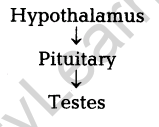
Ans.Hypothalamus It secretes Gonadotropin Releasing Hormones (GnRH).
Pituitary GnRH stimulates the anterior pituitary gland to secrete FSH and LH.
Testes LH stimulates Leydig cells of testes to secrete androgens (like testosterone), which control spermatogenesis. FSH acts on Sertoli cells of testes which in response secrete certain factors necessary for spermiogenesis. The sperm heads become embedded in the Sertoli cells
42.(i) Draw a schematic diagram of a human sperm and label the cellular components. Give the functions of any three parts.
(ii) Where are the sperm heads found embedded to survive after spermatogenesis? [Delhi 2009]
Ans.(i) Human sperm
Diagram showing head of human sperm is The acrosome is filled with enzymes that help in fertilisation of the ovum.

(i)Neck contains two centrioles, a proximal centriole which is necessary for first cleavage division of zygote and a distal centriole, that gives rise to axial filament of tail
(ii)Middle piece possesses many mitochondria to produce energy for the movement of tail to facilitate sperm motility.
(iii)Tail of the sperm consists of an axial filament. Its role is to help movement inside the female reproductive tract towards the ovum for fertilisation.
(iii) Acrosome It contains enzymes required to dissolve the ovum membranes to facilitate contact and penetrate ovum for fertilisation.
Middle piece It contains plenty of mitochondria to produce energy for the movement of sperm.
(a)Head contains acrosome that have enzymes, which help in dissolving ovum membrane for fertilisation.
(b)Middle piece contains many mitochondria, which provide energy for the motility of sperm.
(c)Tail helps in movement of sperm required to reach the ovum.
(ii) The sperm heads become embedded in the Sertoli cells, to derive nutrition, so as to survive after spermatogenesis
43.(i) Given below is the TS of human ovary. Identify the following in the diagram Corpus luteum, Secondary oocyte Antrum, Primary follicle and Primary oocyte.
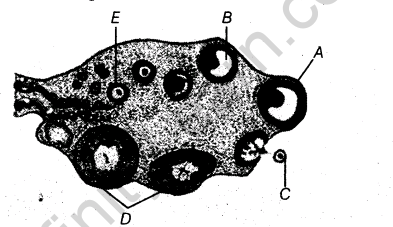
(ii)Explain the changes the primary oocyte undergoes, while in different follicular stages before ovulation.[Foreign 2009]
Ans.The parts identified in given TS of ovary are
A-Graafian follicle
B-Antrum
C-Ovum
D-Corpus luteum
E-Primary follicle
(ii) Changes in primary oocyte before ovulation
- Primary oocyte is surrounded by a layer of granulosa cells and is called primary follicle.
- Many primary follicles degenerate from birth to puberty.
- Primary follicle becomes surrounded by more layers of granulosa cells and becomes the secondary follicle.
- Primary oocyte grows on a stalk and fluid-filled cavity called antrum develops in the follicle, at this stage, it is called the tertiary follicle.
- Primary oocyte undergoes meiosis-l, forming a large secondary oocyte and a tiny first polar body.
- Secondary oocyte forms a new membrane, called zona pellucida around it.
44.Give a schematic representation of oogenesis in humans. Mention the number of chromosomes at each stage. Correlate the life phases of the individual with the stages of the process. [Delhi 2008; Foreign 2008]
Ans.Schematic representation of oogenesis

Oogenesis in different phases of life are as follow:
Embryonic stage Oogenesis starts during the embryonic development stage. At this stage some million oogonia are formed within each foetal ovary. Oogonia start division, enter prophase-l of meiosis, get temporarily arrested at this stage and called as primary oocytes. (l)
Between birth and puberty A large number of primary oocytes degenerate during the period between birth and puberty. About 60000-80000 primary follicles are left in each ovary. (l)
Reproductive period Primary follicles mature once at a time to transform into secondary follicles and then into tertiary follicles.
(i) The primary oocyte completes meiosis-l to form a large haploid secondary oocyte and a tiny first polar body.
(ii) Secondary oocyte starts undergoing meiosis-ll but is suspended at metaphase-ll.
(iii) Mature follicle of the ovary ruptures to release the secondary oocyte, by the process called ovulation (occurs in mid-cycle).
(iv) Secondary oocyte enters the Fallopian tube and completes meiosis-ll when a sperm enters it. It forms a large cell ovum and a second polar body
45.(i) Give a schematic representation of spermatogenesis in humans.
(ii)At which stage of life does gametogenesis begin in human male and female, respectively?
(iii)Name the organs where gametogenesis gets completed in human male and female, respectively. [Delhi 2008]
Ans.(i)A primary spermatocyte undergo first meiotic division leading to two equal, haploid cells called secondary spermatocytes, which contains only 23 chromosomes each.
(a)The secondary spermatocytes undergo the second meiotic division to produce four equal, haploid spermatids.
(b) The spermatids are transformed into spermatozoa (sperms) by the process called spermiogenesis.
(c) Sperm heads are embedded in the Sertoli cells and are finally released from the seminiferous tubules by the process called spermiation.

(d) Human sperm contains four main parts, i.e. Head It contains an elongated, compact, haploid nucleus, i.e. concentrated DNA. The anterior end is covered by a cap-like structure called acrosome. The acrosome contains enzymes that help in dissolving membranes of the ovum for fertilisation.
Neck It contains two centrioles, a proximal centriole, which is necessary for the first cleavage division of zygote and a distal centriole that is connected to the tail filament.
Middle piece It contains a number of mitochondria to provide energy for the motility of sperms.
Tail It consists of an axial filament surrounded by the plasma membrane. Tail helps the sperm to move in the female reproductive tract towards the female gamete for fertilisation.
(ii) Spermatogenesis in human males start at puberty. Oogenesis in human females begins during the embryonic development stage.
(iii) In human males, gametogenesis completes in testes and in females, it completes in Fallopian tube.
46.(i) Draw a labelled diagram of a sectional view of human seminiferous tubule.
(ii) Differentiate between gametogenesis in human males and females on the basis of
(a)Time of initiation of the process.
(b)Products formed at the end of the process.[All India 2008]
Ans.(i))Spermatogenesis is production of sperms in males.
(a) In testis, the immature male germ cells (spermatogonia) produce sperms by spermatogenesis that begins at puberty.
(b)Spermatogonia (sing, spermatogonium) present on the inside wall of seminiferous tubules multiply by mitotic division and increase in numbers.
(c) Each spermatogonium is diploid and contains 46 chromosomes. Some of the spermatogonia called primary spermatocytes periodically undergo meiosis.

(ii) Differences in gametogenesis in human males and females are:
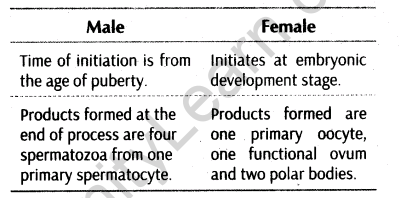
47.Draw a labelled sectional view of a human ovary. Explain the events of oogenesis. [Delhi 2008C]
Ans.Oogenesis is the process of formation of a female gamete or ova in the ovary.
(i)It starts during embryonic stage in a female.
(ii)About a million oogonia are formed in the ovary of the female foetus (of 25 weeks). No new oogonia are formed after birth.
(iii)The oogonial cells start meiotic division, enter into prophase-I, get temporarily arrested at that stage and are called as primary oocytes.
(iv)Each primary oocyte then gets surrounded by a layer of granulosa cells called primary follicle.
(v)A large number of primary follicles degenerate during the phase from birth to puberty. As a result, about 60,000-80,000 primary follicles are left in each ovary at puberty.

Development of ovum from an oogonium in a human female.
(i) Oogonium which enters meiosis-l is the primary oocyte. Division remains suspended in prophase-l.
(ii)Primary oocyte becomes surrounded by a layer of granulosa cells and is called the primary follicle.
(iii) Primary follicle gets surrounded by more granulosa cells and a thecal layer. This stage is called secondary follicle.
(iv) A cavity develops in the secondary follicle around the primary oocyte called antrum.
(v)Thecal layer becomes organised into an outer theca externa and an inner theca interna. This stage is called tertiary follicle.
(vi)Primary oocyte completes its meiosis-l and forms a large cell-the secondary oocyte and a tiny cell-the first polar body.
(vii)Tertiary follicle transforms into a mature follicle called Graafian follicle (mature ovum).
48.Study the graph given below and answer the questions that follow
(i)Name the hormones X and Y.
(ii)Identify the ovarian phases during a menstrual cycle.
(a)5th to 12th day of the cycle
(b)14th day of the cycle
(c)16th to 25th day of the cycle
(iii)Explain the ovarian events (a), (b) and(c)under the influence of hormones X and Y. [All India 2008C]
Ans.(i)X-Leuteinising Hormone (LH)’
Y—Follicle Stimulating Hormone (FSH)
(ii) (a) 5th to 12th day of the menstrual cycle is called follicular phase. The primary follicles grow and become fully mature Graafian follicle.
(b) 14th day of the cycle is called ovulatory phase and marks ovulation.
(c)16th to 25th day is luteal phase. The corpus luteum secretes large amount of progesterone which is essential for the maintenance of the endometrium.
(ii)Secretion of gonadotropins increases gradually during the follicular phase and stimulates follicular development as well as secretion of oestrogens by the growing follicles.Both LH and FSH attain a peak level in the middle of cycle. Rapid secretion of LH leads to LH surge, which induces rupture of follicle and release of ovum,i.e.ovulation.In the secretory phase LH stimulates the remains of Graafian on follicle to develop corpus luteum which secretes large amount of progesterone essential for maintenance of endometrium








